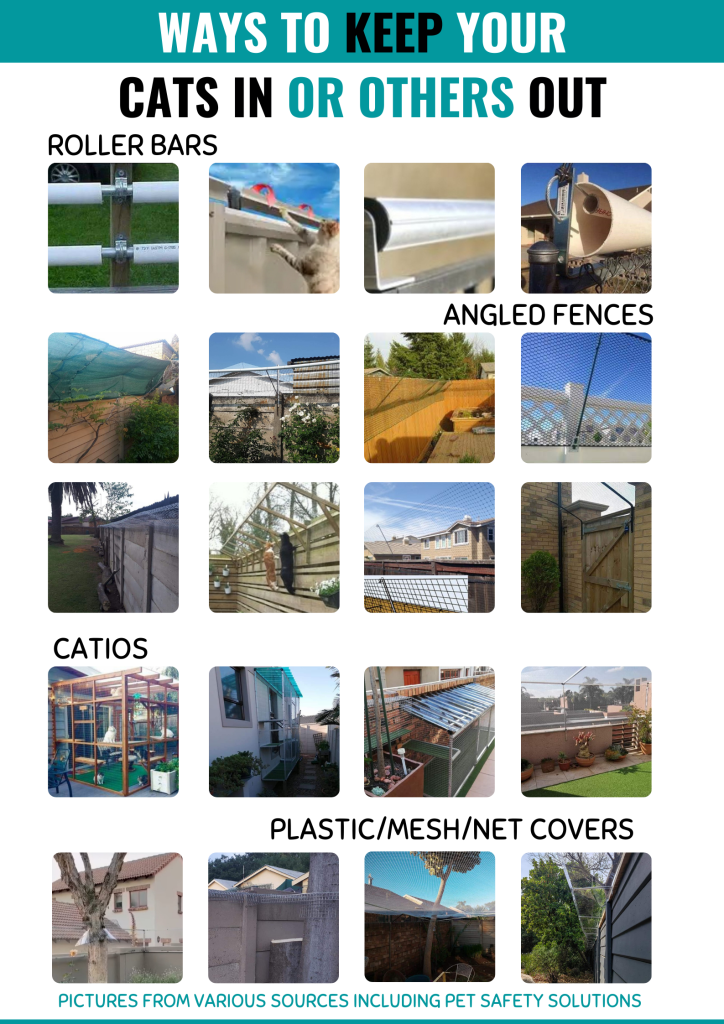
DON’T LET YOUR PETS OUTSMART YOU!
There are constantly pets in the streets and this holds many dangers in a cruel world. If your pets are out and about, they might get injured, hit by a car, attacked by other animals or hurt other animals, get poisoned, get shot, get stolen to sell, breed, or for dog fights. They may also become a nuisance to others, especially cats.
We understand that accidents happen and some animals are really escape artists, but one of a few reasons why animals get out is because IT IS EASY! You get climbers, runners, jumpers, diggers, chewers, some learn to open gates or some pets use a combination of the above. We have seen fox terriers climb trees to get out.
Sadly, irresponsible owners and the organizations that support those behaviours think it is acceptable to let them roam the streets. Luckily, legislation in the form of by-laws is being implemented in certain municipalities and we are hopefull that these large fines will get people to keep their animals safe.
That said, let me be clear on the following: Some people claim that they “have done everything” to keep the animal in…… IF YOUR ANIMAL IS IN THE STREET THEN YOU HAVE NOT DONE ALL YOU CAN TO KEEP THEM INSIDE. If you have, then they will not be in the streets. How do other people do it?
Read more on why your pets escape here.
PRECAUTIONS
Secure your yard, but also take these precautions:
- Sterilize your pets which helps reduce roaming.
- Meet their needs in terms of enrichment (mentally, physically, etc).
- Don’t leave them alone for too long or consider daycare.
- Make your garden their happy place. (Sandpit, sensory garden, etc.)
- Microchip them and register the microchip on more than one database.
- Add a collar ID with your number on it.
- For cats a break-away collar with ID tag.
- Have a recent photo ready.
- Get a responsible pet sitter when you are away.
- When the garden services come, keep your pets inside.
- If possible, keep them in your backyard, away from the street, or only in the front yard with supervision.
- If your maid or gardener has a key, have a stern talk about keeping the gate closed.
- Always check your yard for foreign objects and poisons that may endanger your pets.
- Keep them away from gates & fences and out of sight, to prevent theft.

Petology provides guidelines to equip you with plausible methods to secure your yard and The Paw Company on how to keep your cats in. This can be possible with little investment and effort.
JUMPERS & CLIMBERS
- Have large fences and high walls that can’t be easily climbed (no easy foothold).
- Choose solid panel fences without anywhere for your dog to stick his/her paws. This will also keep your dog a lot calmer since they can’t see what’s on the other side.
- Metal fence panels or palisades can work but you’ll need to make provisions to prevent them from digging under or slipping through.
- Make sure there’s nothing near the wall/ fence that your dog can use to give themselves a boost, like planters, benches, birdbaths, garbage bins, etc.
- Alternatively, you can add an extension to make the fence taller or you can install a 45-degree angle lean-in section (overhang) onto the upper part of your fence/wall with brackets. This tilts in to deter pets from getting over it.
- Another alternative could be to add a roller bar (a.k.a Coyote rollers) made from PVC or Metal, which dogs’ paws can’t hold onto. Both angled fences and roller bars work well for keeping cats in or out too.

DIGGERS, CHEWERS & SLIP THROUGH-ERS
- If you have palisades, you can add safe doggie bars that do not have sharp edges. You can also use a durable welded wire mesh overlay and secure it with cable ties. Not the plastic ones!
- If they squeeze through or dig underneath you can buy or custom-make metal dig-defence barriers with spikes, which go deep into the ground. If your fence is secure, but not your gate, consider a gate plate.
- You can pour a concrete footer along the perimeter of the fence and bury/mount the bottom of the fence into the mixture.
- Install an L-Footer/skirt/apron along the bottom of the fence, facing inwards. You can use a wire mesh fence, hardware cloth, or a piece of chain-link fence attached to the base of the fence. Bury it so that it is not visible, or lay it on top of the grass and hold it down with pins/stakes, rocks, gravel, mulch, or even planters.
- Some people use “bumper collars” which prevent the pet from slipping through, but we do not support this method.
Read out lost and found animal guidelines here.

RUNNERS
- Runners are those who dash out of the yard as soon as the gate opens. This means you will have to get creative to keep them in and it might require more planning and effort, but the effort can never outweigh the safety of your pet.
- In this case, you can consider getting the help of a qualified behaviourist/trainer. Rewarding good behavior is more important instead of punishment or fear-based training. If you call them back and they come, give them a treat or lots of praise (not punishment)! Teach them to sit and wait, when the gate opens.
- Try to limit their access to the driveway or main gate. You can install a double gate, which means you create an enclosed area in the yard. If someone wants to come in or out, they have to go through one gate, then the other gate.
- You can use a temporary fence, portable playpen, enclosed area outside, or a kennel/run to put them in when you know the main gate will be opened.
- If your housing arrangement does not allow the above, then lure your pet into the house when you know the gate will open.

KEEPING CATS IN
- Higher walls (around 2m).
- As mentioned above, roller bars and angled fences work well for cats too.
- Use nets
- Build a Catio
- Plant certain species of plants that cats dislike, but which are not poisonous to cats. Some cats seem to dislike the smell of rue, lavender, pennyroyal, coleus canina, and lemon thyme. Some cats also seem to not like strong citrus cents.
- Trim trees regularly and wrap them with plastic or PVC “dividers”, so they cannot climb high enough to get out.
- If you really cannot apply any of the above, try creating a routine for your cat, for example, a lick of wet food in the morning to make sure they “check in” and again in the evening. Once they are in for the evening, close the doors/windows until the morning.
- Create entertainment for your cats to keep them more indoors.
- Invest in a good quality cat harness. Acclimatize your cat to the harness from a young age. With patience and persistence, older cats will also get used to it.

Consider contacting Pet Safety Solutions. I have not used them myself, but they help owners secure their yards. This is not an endorsement for them by myself or The Bulletin.
Remember to never punish your pets when they come back. This will not take away the desire to escape but will make them afraid of returning home. Always find out why your pets try to get out and address the root cause. If it is a behavioural issue, contact a qualified behaviourist.
Where there is a will there is a way! Don’t let your pets outsmart you!
Next week we will look at the euthanasia of healthy animals and why it is happens.
WHEN YOU KNOW BETTER, DO BETTER!
#secureyard #keeppetssafe #waystokeeppetsin #mypetmyresponsibility